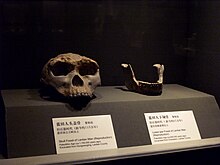
Back Lantianmens Afrikaans Home de Lantian Catalan Lantian-Mensch German Homo erectus lantianensis Spanish انسان لانتیانی Persian Homme de Lantian French Lantianski čovjek Croatian 藍田原人 Japanese 란톈 원인 Korean Lantianmens Dutch
| Lantian Man Temporal range:
| |
|---|---|

| |
| Casts of Lantian Man at the Shaanxi History Museum | |
| Scientific classification | |
| Domain: | Eukaryota |
| Kingdom: | Animalia |
| Phylum: | Chordata |
| Class: | Mammalia |
| Order: | Primates |
| Suborder: | Haplorhini |
| Infraorder: | Simiiformes |
| Family: | Hominidae |
| Subfamily: | Homininae |
| Tribe: | Hominini |
| Genus: | Homo |
| Species: | |
| Subspecies: | †H. e. lantianensis
|
| Trinomial name | |
| †Homo erectus lantianensis (Woo Ju-Kang, 1964)
| |
Lantian Man (simplified Chinese: 蓝田人; traditional Chinese: 藍田人; pinyin: Lántián rén), Homo erectus lantianensis) is a subspecies of Homo erectus known from an almost complete mandible from Chenchiawo (陈家窝) Village discovered in 1963, and a partial skull from Gongwangling (公王岭) Village discovered in 1964, situated in Lantian County on the Loess Plateau. The former dates to about 710–684 thousand years ago, and the latter 1.65–1.59 million years ago. This makes Lantian Man the second-oldest firmly dated H. erectus beyond Africa (after H. e. georgicus), and the oldest in East Asia. The fossils were first described by Woo Ju-Kan in 1964, who considered the subspecies an ancestor to Peking Man (H. e. pekinensis).
Like Peking Man, Lantian Man has a heavy brow ridge, a receding forehead, possibly a sagittal keel running across the midline of the skull, and exorbitantly thickened bone. The skull is small by absolute measure, and has narrower postorbital constriction. The teeth are proportionally large compared to other Asian H. erectus. The brain volume of the Gongwangling skull is about 780 cc, similar to contemporary archaic humans in Africa, but much smaller than later Asian H. erectus and modern humans.
Lantian Man inhabited the mild grasslands at the northern base of the Qinling Mountains. For stone tools, Lantian Man manufactured mainly heavy-duty tools including choppers, spheroids, heavy-duty scrapers, handaxes, picks, cleavers. The latter three are characteristic of the Acheulean industry, which is usually only applied to African and Western Eurasian sites. It appears the Acheulean persisted far longer in this region than elsewhere.